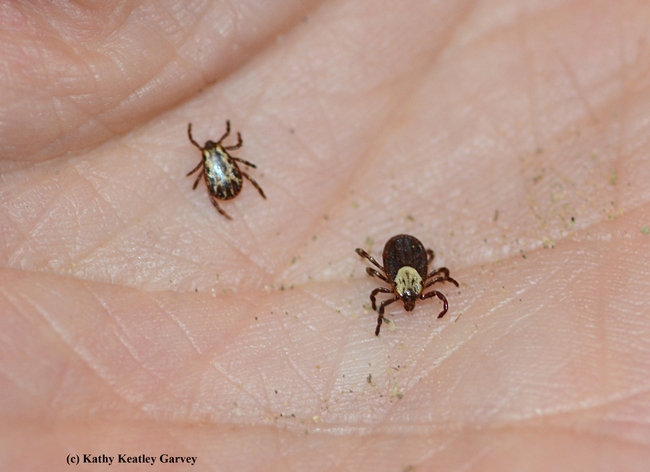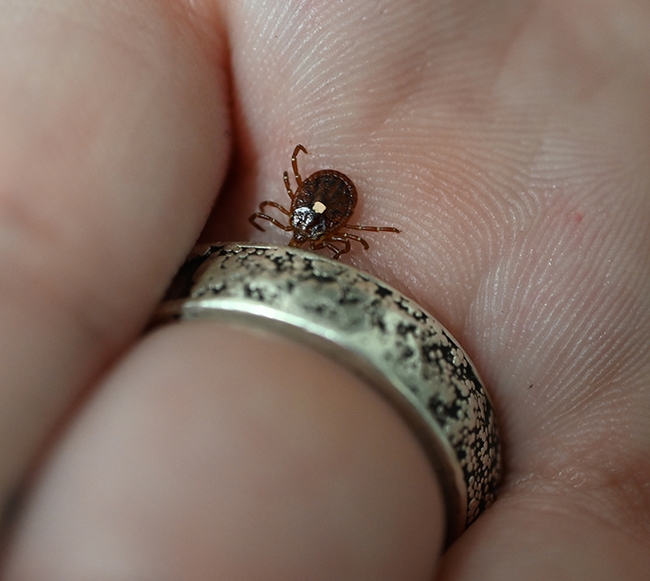- Author: Kathy Keatley Garvey
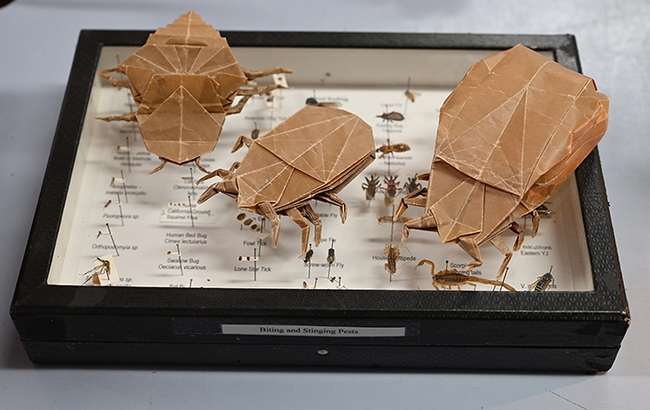
They learned that "medical entomologist is the study of arthropods (such as insects and ticks) that spread pathogens that cause human disease. It is also important to study insects and arthropods that spread diseases to other animals! This field o study is called veterinary entomology. Some diseases affect both humans and animals. This is called a zoonotic disease." (from Bohart Museum poster)
They asked questions. They observed "the vampires" through microscopes. And they left with first-hand information.
The presenters included:
-
Robert "Bob" Kimsey, forensic entomologist, Department of Entomology and Nematology, who answered questions about medical entomology.
-
Luz Maria Robles, public information officer, Sacramento-Yolo Mosquito and Vector Control District, who discussed and displayed mosquitoes and how to keep yourself safe. See https://www.fightthebite.net/
- Carla-Cristina "CC" Melo Edwards, doctoral student and mosquito researcher in the laboratory of medical entomologist-geneticist Geoffrey Attardo, associate professor of entomology, UC Davis Department of Entomology and Nematology, who fielded questions about mosquitoes. Attardo displayed enlarged images of mosquitoes, including a blood-fed Aedes aegypti, and a female and male Culex tarsalis.
- Moriah Garrison, senior entomologist and research coordinator with Carroll-Loye Biological Research (CLBR), (owned by doctoral scientists Scott Carroll and Jenella Loye, affiliated with the Department of Entomology and Nematology), displayed live ticks and mosquitoes.
- Nazzy Pakpour, UC Davis alumna, Novozymes scientist and author, displayed her newly published children's book, Please Don't Bite Me
For the occasion, UC Davis alumnus Kevin Murakoshi, gifted the Bohart Museum a trio of origami sculptures: a tick, an engorged tick and a bedbug. At an earlier open house, he presented the museum with origami sculptures of praying mantises. "They're beautiful," said UC Davis distinguished professor Lynn Kimsey, director of the Bohart Museum. "We're going to display them in our hallway."
The museum houses a global collection of eight million insect specimens, plus a live insect petting zoo (including Madasgascar hissing cockroaches and walking sticks), and a gift shop. It is located in Room 1124 of the Academic Surge Building, 455 Crocker Lane. UC Davis.
The next open house, themed "Monarchs," is set for Saturday, Nov. 4 from 1 to 4 p.m. All open houses are free and family friendly and include a family arts-and-crafts activity. For more information, contact the Bohart Museum at bmuseum@ucdavis.edu or telephone (530-752-0493.
(Part 2 of the open house will be published Friday, Sept. 29)
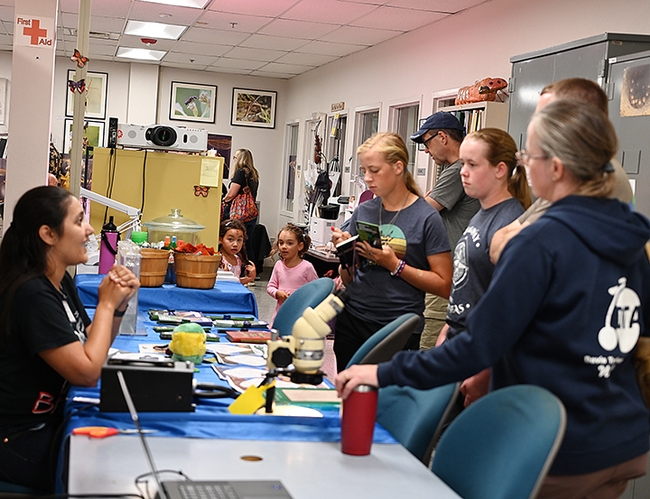

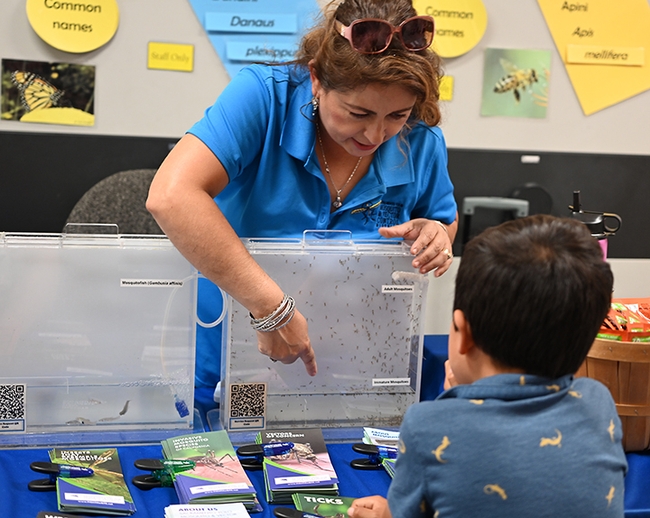
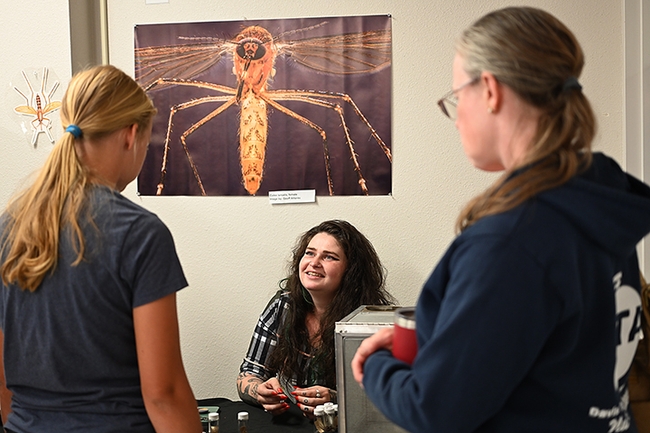
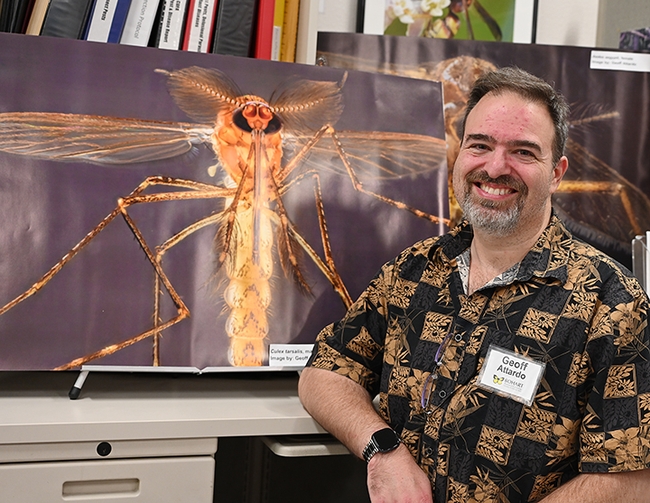
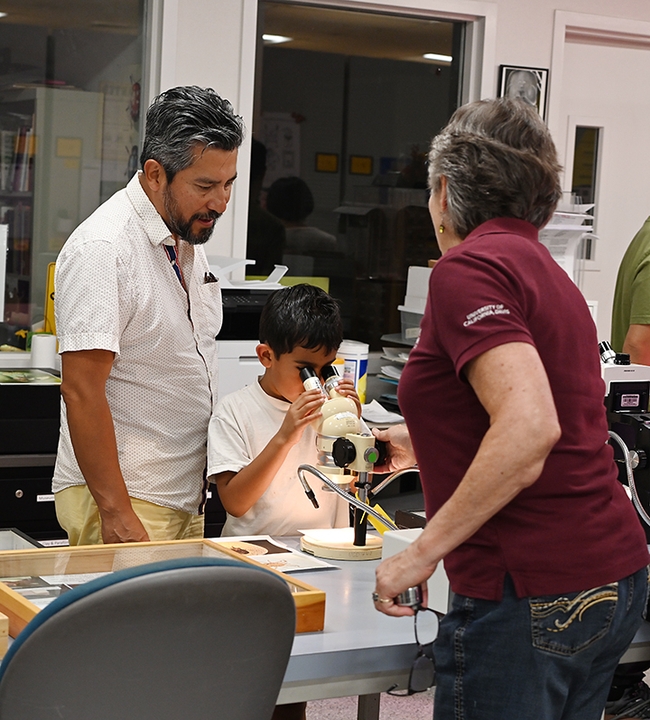
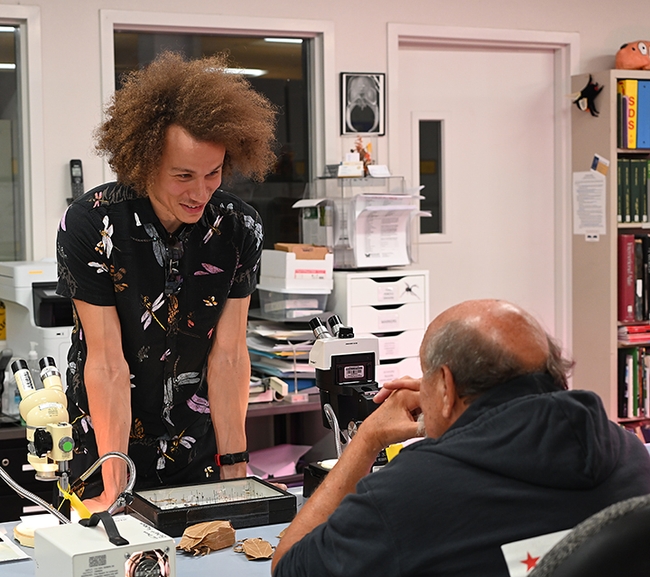
- Author: Kathy Keatley Garvey
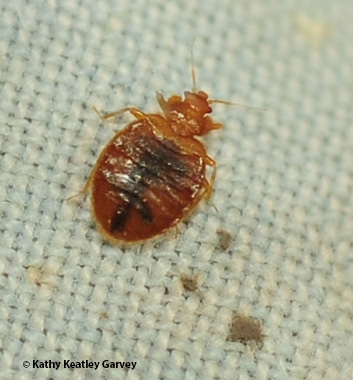
The open house set from 1 to 4 p.m., Saturday, Sept. 23 in Room 1124 of the Academic Surge Building, 455 Crocker Lane, UC Davis. It's free and family friendly and parking is also free. It's an opportunity for attendees to learn more about the "nuisance insects," and ask questions.
The line-up, as of today:
- Lynn and Bob Kimsey of the UC Davis Department of Entomology and Nematology faculty. Lynn, a hymenopterist, is a UC Davis distinguished professor who teaches general entomology and the biodiversity of California insects and serves as the director of the Bohart Museum, and Bob is a forensic entomologist, specializing in public health entomology; arthropods of medical importance; zoonotic disease; biology and ecology of tick-borne pathogens; tick feeding behavior and biochemistry.
- Carla-Cristina "CC" Melo Edwards, a first-year doctoral student in the laboratory of medical entomologist-geneticist Geoffrey Attardo, associate professor of entomology, UC Davis Department of Entomology and Nematology. She will share her expertise on mosquitoes and show specimens.
- Moriah Garrison, senior entomologist and research coordinator with Carroll-Loye Biological Research (CLBR). She is scheduled to show live ticks and mosquitoes and field questions.
- Educators from the Sacramento-Yolo Mosquito and Vector Control District. They will discuss mosquitoes and their program
- Nazzy Pakpour, UC Davis alumna, Novozymes scientist and author of Please Don't Bite Me
- Jeff Smith, curator of the Bohart Museum's ;Lepidoptera (butterflies and moths) collection. He will display butterfly specimens collected globally. Also on the "Lep crew" are Bohart volunteers Greg Kareofelas and Brittany Kohler.
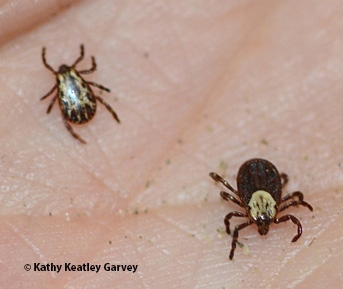
Petting Zoo. A popular attraction is the live petting zoo; visitors are encouraged to hold or get acquainted with live Madagascar hissing cockroaches and stick insects
Family Arts and Crafts Activity. The event will be held outside and will highlight two collecting techniques, said Tabatha Yang, education and outreach coordinator.
- Clear Packing Tape Art. "Clear packing tape is a good way to collect small, hard-to-see insects," Yang said. "Glitter will mimic small insects like fleas or bed bugs. Putting the tape on white paper makes it easy to look at them under a microscope and for this craft it will make a pretty card."
- Making insect collecting or "kill" jars. Participants are asked to bring a recycled jar. "This should be a clean and dried glass jar with a wide, metal top--think jam, pickle, peanut butter jars. Four to 16-ounce jars work well. We will have some on hand as well, but recycling is good! We will fill the bottom with plaster of paris and let it dry and teach people how to use it properly, using something like nail polisher remover containing ethyl acetate as the killing agent. A UC Davis Department of Entomology and Nematology video explains the procedure: https://youtu.be/s8yCzFGzbn8?si=71sNmA5l8NyP1zj0


- Author: Kathy Keatley Garvey
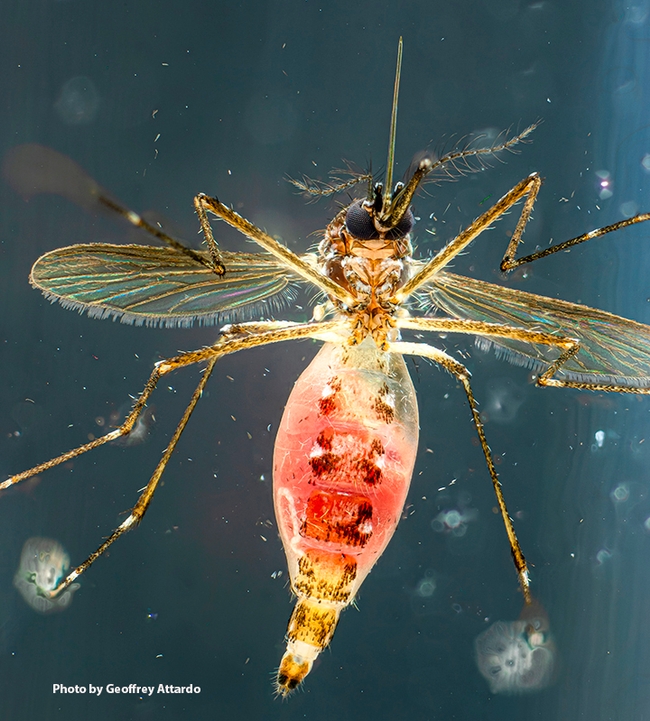
When the Bohart Museum of Entomology hosts an open house on "Household Vampires" from 1 to 4 p.m., Saturday, Sept. 23, activities will take place both inside and outside.
Inside? The presenters will talk about mosquitoes, bed bugs, fleas and ticks in Room 1124 of the Academic Surge Building, 455 Crocker Lane, UC Davis campus. They will show live insects and specimens and field questions.
Outside? The latest news is the family arts and crafts activity.
Tabatha Yang, education and outreach coordinator, announced the the arts and crafts activity "will highlight two collecting techniques."
- Clear Packing Tape Art. "Clear packing tape is a good way to collect small, hard-to-see insects," Yang said. "Glitter will mimic small insects like fleas or bed bugs. Putting the tape on white paper makes it easy to look at them under a microscope and for this craft it will make a pretty card."
- Making insect collecting or "kill" jars. Participants are asked to bring a recycled jar. "This should be a clean and dried glass jar with a wide, metal top--think jam, pickle, peanut butter jars. Four to 16-ounce jars work well. We will have some on hand as well, but recycling is good! We will fill the bottom with plaster of paris and let it dry and teach people how to use it properly, using something like nail polisher remover containing ethyl acetate as the killing agent. A UC Davis Department of Entomology and Nematology video explains the procedure: https://youtu.be/s8yCzFGzbn8?si=71sNmA5l8NyP1zj0
Inside, the presenters will include:
- Lynn and Bob Kimsey of the UC Davis Department of Entomology and Nematology faculty. Lynn, a hymenopterist, is a UC Davis distinguished professor who teaches general entomology and the biodiversity of California insects and serves as the director of the Bohart Museum, and Bob is a forensic entomologist, specializing in public health entomology; arthropods of medical importance; zoonotic disease; biology and ecology of tick-borne pathogens; tick feeding behavior and biochemistry.
- Carla-Cristina "CC" Melo Edwards, a first-year doctoral student in the laboratory of medical entomologist-geneticist Geoffrey Attardo, associate professor of entomology, UC Davis Department of Entomology and Nematology. She will share her expertise on mosquitoes and show specimens.
- Moriah Garrison, senior entomologist and research coordinator with Carroll-Loye Biological Research (CLBR). She is scheduled to show live ticks and mosquitoes and field questions.
- Educators from the Sacramento-Yo;o Mosquito and Vector Control District. They will discuss mosquitoes and their program
- Nazzy Pakpour (Novozymes scientist and author of Please Don't Bite Me)
- Jeff Smith, curator of the Bohart Museum's Lepidoptera (butterflies and moths) collection. He will display butterfly specimens collected globally. Also on the "Lep crew" are Bohart volunteers Greg Kareofelas and Brittany Kohler.
Professor Attardo, who maintains a lab website on Vector Biology and Reproductive Biology at http://attardo-lab.com, and chairs the Designated Emphasis in the Biology of Vector-Borne Diseases, will display some of his mosquito images, including a blood-fed Aedes aegypti, and a female and male Culex tarsalis. Alex Wild, a UC Davis doctoral alumnus and curator of entomology, University of Texas, Austin, will display an image of mosquito larvae that currently hangs in Briggs Hall, home of the UC Davis Department of Entomology and Nematology. Wild's insect images can be viewed on his website, https://www.alexanderwild.com.
The Bohart Museum houses a global collection of eight million insect specimens; a live petting zoo (including Madagascar hissing cockroaches and stick insects); and an insect-themed gift shop stocked with books, posters, T-shirts, hooded sweatshirts and jewelry.
Resource:
Bohart Museum to Spotlight Household Vampires (UC Davis Department of Entomology and Nematology, Sept. 14, 2023)
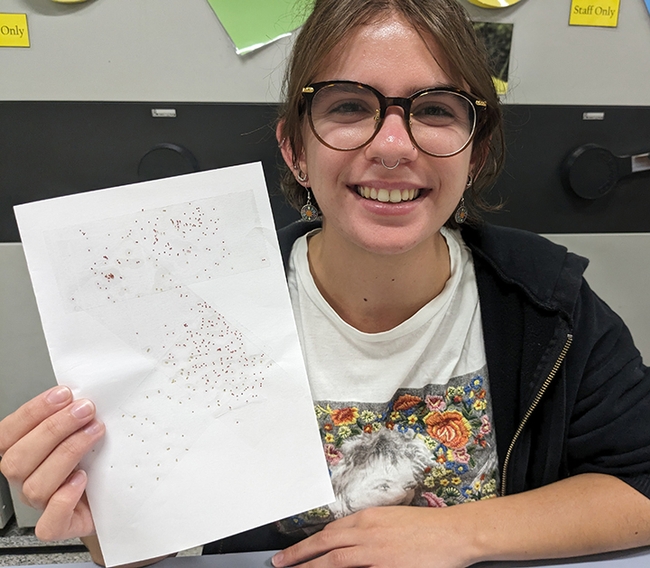
- Author: Kathy Keatley Garvey

So Joe Nazarius of Winters embarked on a Dec. 30th hike in the Knoxville Road area, west of Lake Berryessa, when the unexpected happened.
"What is this bug buried in Joe's skin?"
That's what his wife, Debra LoGuercio DeAngelo, messaged me. She attached a photo.
Before I could read and respond, a trip to a nearby hospital's urgent care center confirmed its identity: a tick.
Lynn Kimsey, director of the Bohart Museum of Entomology at the University of California, Davis, and a UC Davis distinguished professor of entomology, further identified it as a "black-legged tick nymph (Ixodes pacificus). He should pull it out immediately as their saliva is pretty potent."
Yes and yes.
"It's definitely tick season," Professor Kimsey added. "Black-legged ticks are really winter-early spring ticks, followed by the common dog tick, which is the late spring-summer tick.”
Kimsey, who fields scores of questions about ticks, wrote a fact sheet on ticks (see below), posted on the Bohart Museum website:
"The tick mouthparts are called the hypostome, which has many backward directed projections. The projections prevent easy removal of the attached tick. Most hard ticks also secrete a cement-like substance from the salivary glands that literally glues the feeding tick in place. The substance dissolves after feeding is complete. When a tick is removed, this is the material left behind, not the 'head.'
"Many ticks seek hosts by 'questing.' Questing ticks crawl up the stems of grass or perch on the edges of leaves in a typical posture with the front legs extended. Certain chemicals, such as CO2, as well as heat and movement cause questing behavior. Ticks climb onto a potential host that brushes against their extended front legs. Once on a host, hard ticks may feed for several days to several weeks."
Kimsey also covered ticks in her lead article, "California Ticks, Myths and Disease," of the winter 2018 Bohart Museum Society newsletter (see entire article at the end of this blog):
"Although we're still a few months away from spring this seems like a good time to write about ticks, since at least one species, the western deer tick will be active soon. There are nine commonly encountered species of tick found in California, classified in two different groups, the soft ticks, family Argasidae, and the hard ticks, family Ixodidae.
"Ticks generally go through four stages, egg, larva, nymph and adult. After the larva hatches from the egg, each successive stage requires a blood meal to develop to the next stage. The transition from one stage to the next, except for the egg to larva transition, requires a blood meal. Soft ticks may have two or more nymphal stages, each requiring a blood meal. As a result it may take up to 3 years to complete their life cycle. Larval ticks differ from nymphs and adults because they only have six legs while the other stages have eight.
"Tick bites can range from annoying to downright painful. When a tick attaches itself to a host, the first thing it does is insert its mouthparts into the skin. The tick then secretes saliva that anchors them in the skin and causes tissues in the vicinity to leak, and this plug is what's actually left behind when a tick is removed, not the head. The tick saliva causes the adjacent skin cells and lymphatic fluid to leak into the bite wound. When hard ticks feed it takes several days before blood begins leaking into the vicinity of the tick's mouthparts. Only then can transmission of blood borne pathogens like the ones that cause Lyme disease take place."
But back to "The Tick" that interrupted an end-of-the-year hike.
Most people might not pull out their cell phone to grab an image of a tick, but Debra LoGuercio DeAngelo is a journalist. She's a former editor of the Winters Express newspaper and author of two newly published books (The Elements of Horse Spirit: the Magical Bond Between Humans and Horses and Pagan Curious: A Beginner's Guide to Nature, Magic & Spirituality and a third one is pending publication in August, Sacred Massage--The Magic & Ritual of Soothing Touch)
With a click, Debra captured an extremely sharp image of "The Tick" that ticked them off.
No, her pending book on "soothing touch" has nothing to do with arachnids questing near Lake Berryessa and feasting on an unsuspecting hiker...but this talented writer may also have a future in tick photography...
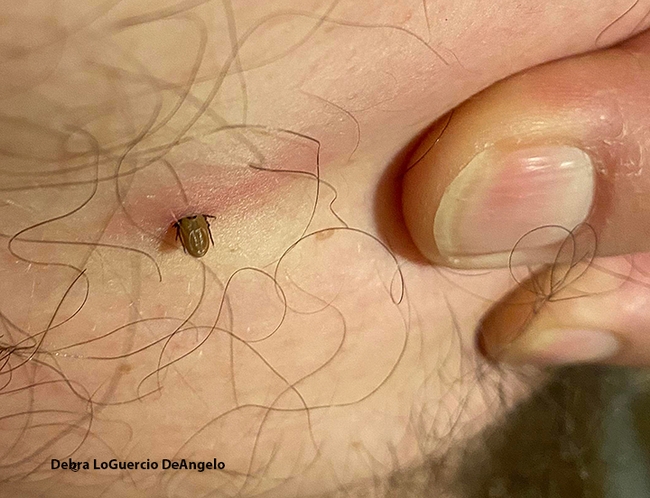
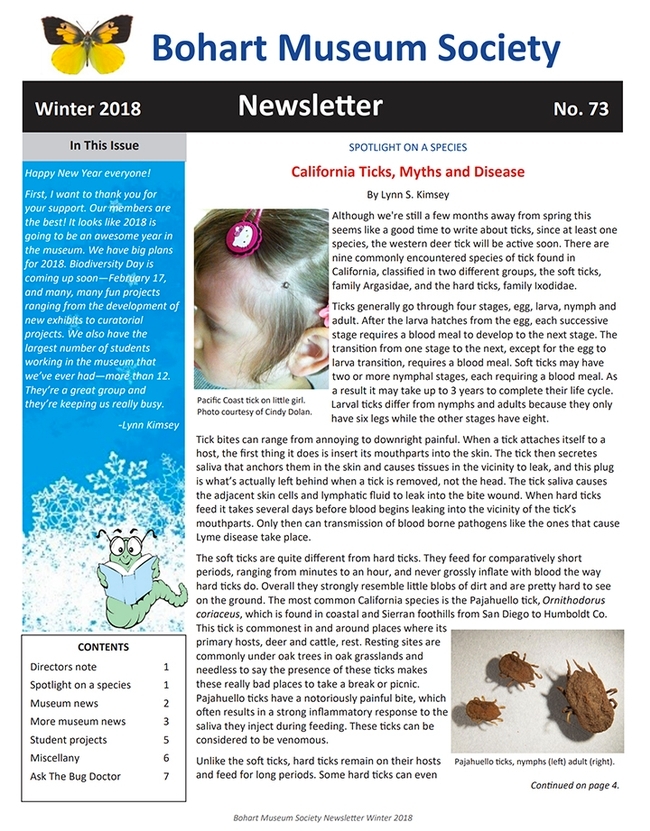
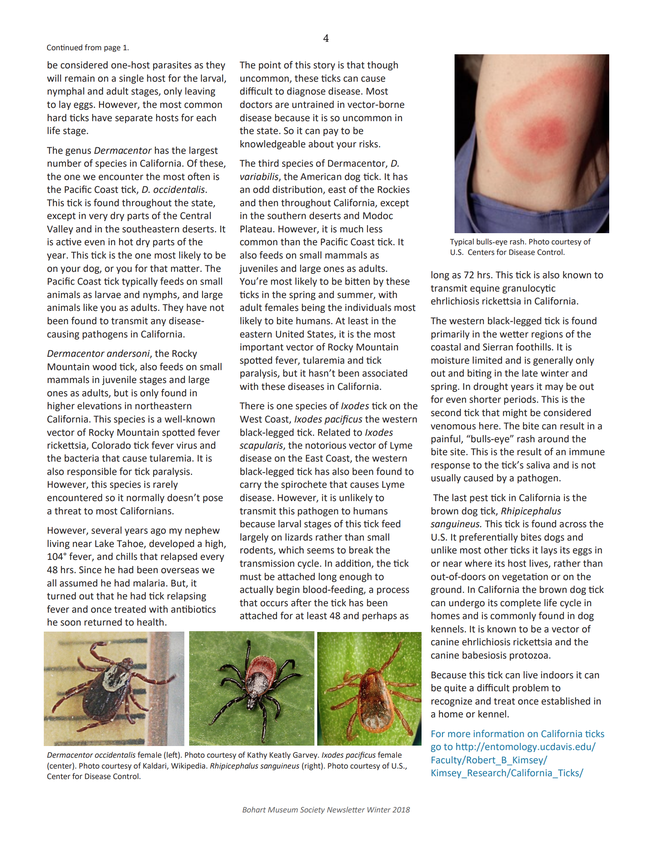
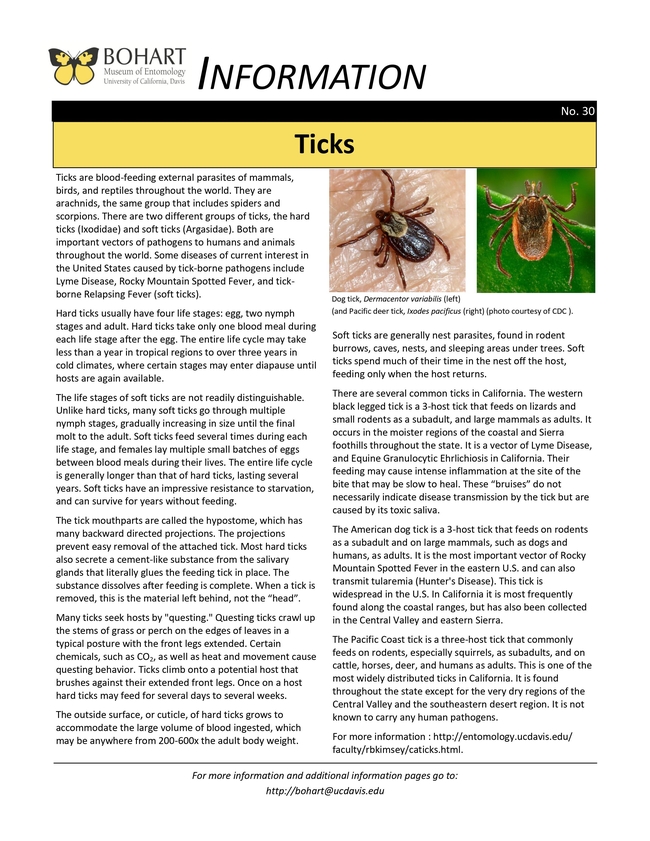
- Author: Kathy Keatley Garvey

Ticks can do that to you.
I never think about ticks during the holiday season, but a news release from the University of Cincinnati about how “Hungry Ticks Work Harder to Find You” piqued my interest--and memories of the day our family inadvertently “collected” a total of 14 ticks.
But first, the news release about this fascinating research...
UC writer Michael Miller described ticks as “hardy little brutes that can go as long as a year without a meal,” and that “the hungrier ticks are, the harder they try to find you or other hosts.”
Biologist Andrew Rosendale, lead author of the study and UC adjunct assistant professor of biology, said that starved ticks are more likely to look for a host and they're more likely to attach to the host longer “which provides a greater opportunity to transmit diseases.”
Ticks, as you know, feed on blood. They feed on blood as larvae, nymphs and adults. Ticks "spend most of their lives on the ground in tall grass, patiently biding their time for a victim and presumably ignoring their rumbling stomachs,” Miller wrote in his news story.
Fact is, ticks are very good at waiting, waiting to ambush you. They can reach near starvation because their metabolism slows. “In the absence of any host cues, they go into a dormant state where they don't move around a lot,” UC biology professor Joshua Benoit related.
Then there's "questing."
Miller explained that “In the wild, adult ticks explore the undergrowth and climb tall grass. They reach out with the claws on their forelegs, a behavior called questing, to snag an animal's fur or your denim jeans. Then they burrow into their hosts with mouthparts shaped like ratchets that keep them in place....In the lab, UC researchers stimulated the ticks' questing behavior by breathing into identical glass cylinders. (Ticks can sense carbon dioxide so they know when a possible meal is close at hand.) Biologists recorded differences in activity between just-fed ticks and starving ones. They found that starved ticks had higher activity levels and increased questing behavior than recently fed ones.”
Miller also pointed out that “after three months without food, a tick's metabolism actually increases significantly--by as much as 100 percent--and remains at this higher rate for weeks in association with its increased activity.”
“Likewise, UC biologists found that genes related to immunity were activated by starvation, which could be another survival mechanism," Miller wrote. "Animals that feed on blood must have a immune system capable of fighting bacteria and other microorganisms. By activating genes associated with immunity, ticks might be preparing for an imminent meal.”
Another discovery: the UC biologists found that genes associated with a starved tick's salivary glands activated those glands. “Saliva is known to help ticks drink more blood more quickly, a useful ability when you're clinging precariously to a moving animal in thick brush," Miller wrote. "The sticky saliva also helps cement the tick to the host."
Added Rosendale: “The more they were starved, the more they were priming themselves for that next blood meal.”
And about our family's “tick-collecting trip?”
It was April 14, and the two of us and two dogs were walking through a tall grassy area in Sonoma, enjoying the poppies, fresh vegetation and the springlike weather. When we returned home, we found a total of 14 ticks: 13 either in or on our hair, skin or clothing, and one attached to our Chihuahua mix.
Lynn Kimsey, director of the Bohart Museum of Entomology and professor of entomology at UC Davis, identified them as Dermacentor occidentalis (Pacific Coast tick). Thankfully, this species does not transmit Lyme disease.
We never thought about wearing a repellent that day, but a spokesperson at the Sacramento-Yolo Mosquito and Vector Control District's booth at UC Davis Picnic Day last April said she sprays her clothing with "Off" before she dons the clothing and ventures out into tall grass or brushy areas--or where ticks are likely to be.
She handed out brochures, but you can also read more about ticks (and lyme disease) on the Sac-Yolo website at https://www.fightthebite.net/ticks-and-lyme-disease/ or download the brochure at https://www.fightthebite.net/download/brochures/Ticks.pdf
The brochure indicates that "Ticks do not fly, jump, or fall out of trees! They are usually found in grassy areas, in brush, or in a wooded area. They wait on the tips of vegetation for a human or other animal host to pass by. As the host brushes against it, the tick makes contact, looks for a suitable location, and begins the feeding process."
And "contrary to popular belief, ticks DO NOT embed their heads in skin. Ticks are equipped with mouthparts adapted to penetrate and hold fast in the skin of its host. Additionally, they secrete a cement-like material that helps them stay attached to their host."
Yes, they do. One tick embedded itself in my ear.
I think it must have been one of near-starvation ticks with ultra sticky saliva...
